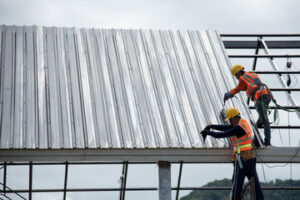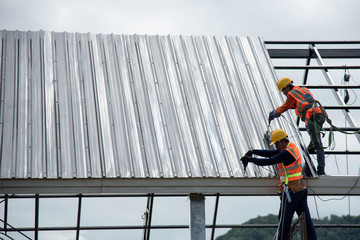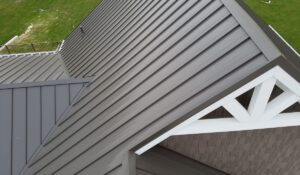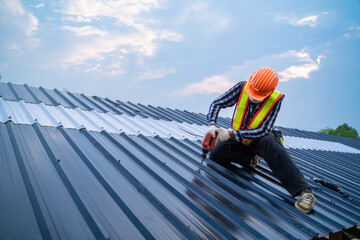Several metal roofing styles are available to match your home’s architectural style. A reputable roofing contractor like Metal Roofing Baton Rouge can help you choose the best style for your budget and local climate conditions.

Metal roofs are relatively easy to install, but they have specific specifications that should be carefully considered before DIY installation. A professional should be consulted and hired unless you have the proper tools and experience.
Metal roofs have a long lifespan and are resistant to the elements. They can last two to three times longer than a roof made with asphalt shingles. This longevity can save homeowners money on repair, replacement and maintenance costs over the years. Additionally, metal roofing can increase the resale value of their home.
When choosing a metal roofing material, it is important to consider the climate and desired aesthetics of the property. Steel, galvanized and aluminum are popular metal roofing options. Each type of metal has unique properties that make it a good choice for different environments and architectural styles. The thickness of the metal roof is also an important factor in durability. Corrugated metal roofs are typically available in 29 and 26 gauge thicknesses while standing seam metal roofs are usually 24 gauge. Thicker panels are generally more durable but may add to the overall cost of the roof.
The primary benefit of a metal roof is its longevity. Many manufacturers offer 50-year warranties on their products. While the upfront cost of a metal roof is often higher than that of a shingle roof, it can save homeowners money on re-roofing expenses over time.
A metal roof can withstand the elements well, but it is important to have it installed by an experienced roofer. If not properly installed, the roof can be susceptible to corrosion, especially in humid climates. A professional roofer will be able to install the proper insulation and coatings to minimize corrosion.
Another common concern people have about a metal roof is the noise that it produces during rainstorms. While this is not always a problem, it can be a nuisance for some families. A qualified roofer can reduce the amount of noise produced by a metal roof by installing the proper insulation and using a sound barrier.
Another important aspect of a metal roof is its ability to resist fire. While a metal roof can be more expensive than a traditional shingle roof, it can provide significant savings on insurance premiums due to its fire resistance. Additionally, a metal roof can help to regulate indoor temperature, which can further lower energy costs.
Energy Efficiency
A metal roof reflects more sunlight than it absorbs, keeping the home cooler and cutting energy costs. It’s also available in a range of colors and finishes that can complement any style home, giving homeowners the option to save on cooling bills while still adding curb appeal. Additionally, a cool metal roof can qualify for the Federal Energy Efficiency Tax Credit, further reducing installation and operational costs.
Many metal roofing systems are made from galvanized steel or aluminum. When it comes to thermal emittance, these materials rate highly compared with other roofing types such as asphalt singles or shingles. Their atomic structure has free-flowing electrons that allow them to easily transfer and release heat energy. When a metal roof is heated by the sun, these electrons quickly move across its surface and into the air around the house. This helps to keep the attic and the living areas much cooler than dark shingles that absorb heat and then radiate it into the home, forcing the HVAC to run continuously to cool the space.
With a high reflectivity rating, metal roofs can keep as much as 70 percent of the sun’s solar energy from reaching the attic or the living spaces inside the home. When a metal roof is coated with an infrared-reflective pigment, this ability increases even further. This reduces heating and cooling costs while lowering the impact on the environment by reducing energy consumption and greenhouse gas emissions such as carbon dioxide, sulfur oxide and nitrous oxide from power plants.
If your neighborhood has an HOA, it’s important to know whether they’ll allow a metal roof before you consider it for your home. Some HOAs may have regulations against these roofs or require homeowners to get permission before choosing them, which could significantly reduce the value of your home. However, an experienced roofing contractor can help you navigate the HOA’s requirements and find a solution that works for everyone. This way, you can enjoy the cost savings and environmental benefits of a metal roof without losing out on the potential to sell your home later down the road.
Aesthetics
Residential metal roofing is a style statement that elevates your home’s exterior. With a wide range of styles, profiles, colors and finishes to choose from, homeowners have the power to create their preferred exterior aesthetic. From the classic appeal of standing seam metal roofs to the charming resemblance of shingles, there are plenty of options for any architectural design preference.
For traditional ranch homes, a metal roof offers the rustic charm they desire. In addition, it can be complemented with other exterior materials to add texture and dimension. Depending on the roof’s color, it can also reflect sunlight and reduce heat build-up, potentially decreasing cooling costs. For a contemporary option, consider metal panel roofing that features concealed fasteners for a sleek appearance. SL-16 and LokSeam panels are both ideal for this home style, providing sleek lines without exposed screws.
Corrugated metals are no longer the only option for industrial-style homes, as they now offer an aesthetic suitable for a variety of architectural preferences. Standing seam metal roofs provide clean lines and a minimalist aesthetic, while varying panel widths, heights and depth of ribs can add further detail.
A metal roof can also complement other architectural elements such as windows and doors to provide a cohesive look. Stone-coated metal roofing is an excellent example, as it captures the natural look of slate and wood shakes while blending in beautifully with traditional asphalt shingles.
The right finish on a metal roof is not only important for preserving the life of the material, but can also have a significant impact on the visual appeal of your home’s exterior. The most popular finish for a metal roof is zinc, which is naturally corrosion resistant and rust-proof. Zinc is also durable, providing a long-lasting, maintenance-free roof for your home.
If you’re looking for a metallic hue that will stand out, copper is an excellent choice. While it’s more expensive than other metals, its unique patina will enhance the aesthetic of your home while resisting weathering and rusting. Another great alternative is PVDF, which provides an attractive color that lasts up to twice as long as other finishes.
Maintenance
Metal roofing is a great choice for homes and buildings, offering long lifespans and energy efficiency. However, even the best roofs require maintenance and care to keep them looking good and working properly.
One of the most important aspects of maintaining your metal roof is regularly cleaning it to remove dirt, grit, and airborne debris. Regular cleaning will help to keep your metal roof protected from water damage and rust. It is also a good time to check for signs of wear and tear or damage, such as loose screws, dents, corroded washers, and leaks. If you find any problems, call a professional for repairs as soon as possible.
In addition to cleaning your metal roof, you should also make sure that gutters and drains are clear of clogs and working properly. If rainwater is allowed to pool on your roof, it can cause damage, rust, and even a structural collapse. You should also trim nearby trees to avoid branches and leaves falling on the roof, as they can scratch and dent the surface of your roof.
It is never recommended to walk on your metal roof, as this can cause damage and scratches. Instead, if you must go onto your roof for a detailed inspection, you should use a ladder and have someone spot you and hold it for safety measures.
If you notice any holes, gaps, or cracks in your metal roof, seal them immediately with a caulking or sealing product that is compatible with your roofing material. Depending on the extent of the damage, you may need to replace some of your roof panels or have a professional repair it.
As with any type of roof, it is a good idea to have a roof inspection performed by a professional at least twice a year. A roofer can inspect your roof for any areas of damage, clean it, and make any necessary repairs. They can also check your roof for any signs of leaks, which if left unattended can lead to mold growth and interior water damage. They can also ensure that all screws are tight and secure.






